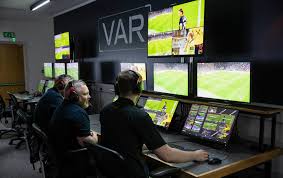In this digital age, technology has permeated every aspect of our lives, including the world of sports. Football, being the most popular sport globally, has not been immune to the influence of technology. From goal-line technology to video assistant referees, advancements in technology have had a profound impact on modern football.
In this article, we will discuss the various ways in which technology has reshaped the game. We will explore the evolution of goal-line technology and its impact on goal-line decisions. Additionally, we will discuss the introduction of VAR (Video Assistant Referee) and how it has brought a new level of fairness and transparency to decision-making in football.
But technology in football goes beyond just ensuring accurate outcomes on the field. It has also revolutionized performance analysis and player tracking. Through innovations such as player tracking systems and data analytics, coaches and clubs can now make more informed decisions in terms of training, tactics, and player development.
Join us as we explore the world of technology in modern football and uncover the ways it is shaping the beautiful game.
Key Takeaways:
- Technology advancements have greatly impacted modern football
- Goal-line technology ensures accurate goal-line decisions and eliminates human error
- The introduction of VAR has brought fairness and transparency to decision-making
- Technology has enhanced performance analysis and player tracking in football
- We are witnessing a new era where technology is redefining the way the game is played and managed
The Evolution of Goal-line Technology
In today’s modern football, goal-line technology has become a game-changer, revolutionizing goal-line decisions and elevating the accuracy of outcomes. This innovative technology has effectively eliminated the margin for error that was previously associated with human judgment.
Goal-line technology was introduced in response to the need for more precise decision-making in critical moments of the game. It leverages advanced systems and sophisticated cameras to determine whether a ball has crossed the goal line or not. This eliminates any ambiguity and ensures that fair and accurate decisions are made.
One of the key benefits of goal-line technology is its immediate impact on the outcome of matches. Gone are the days of controversial goal-line incidents and the debates that followed. With goal-line technology, there is no room for doubt or subjective interpretation. The system provides conclusive evidence, allowing referees to confidently make the right call.
Moreover, the introduction of goal-line technology has had a profound impact on the overall fairness of the game. It ensures that all teams are given equal opportunities and that the result of a match is solely based on skill and performance, rather than human error. This has led to a more level playing field, enhancing the integrity and credibility of football competitions.
Goal-line technology has also brought about a sense of transparency and accountability in refereeing decisions. Fans and viewers can now witness the accuracy of a goal-line decision in real-time, through replays and graphical overlays. This increases the trust and confidence in the game’s officials and contributes to the overall enjoyment and satisfaction of football fans.


The Evolution of Goal-line Technology:
- Early experiments with goal-line technology in the early 2000s
- The approval and implementation of goal-line technology by FIFA
- The different types of goal-line technology systems used today
- The accuracy and reliability of goal-line technology
- The integration of goal-line technology in major football leagues and tournaments worldwide
- The future prospects and advancements in goal-line technology
As the game of football continues to evolve, goal-line technology stands as a testament to the positive impact that technological advancements can have on the sport. By ensuring accurate goal-line decisions, it preserves the integrity of the game and provides a fairer playing field for all teams. The evolution of goal-line technology has truly changed the dynamics of football, bringing precision, certainty, and excitement to every goal-line incident.
The Introduction of VAR in Football
In recent years, the introduction of VAR (Video Assistant Referee) has sparked both excitement and controversy in the world of football. VAR is a technological innovation that has revolutionized the way decisions are made on the field, bringing a new level of fairness and transparency to the game.
With VAR, referees now have access to a suite of video replay tools that allow them to review and reconsider crucial moments in a match. Whether it’s a goal, a penalty, a red card, or any other game-changing incident, VAR provides an extra set of eyes to ensure accurate decision-making.
This video assistant referee technology has significantly impacted the game by reducing the margin of error in officiating. It has the potential to resolve contentious situations, clarify disputed calls, and ultimately improve the overall integrity of the sport.
However, VAR is not without its challenges. The implementation of this technology has been met with criticism and debate. Some argue that the introduction of VAR has disrupted the flow of the game, causing delays and interrupting the natural rhythm of play. Others believe that it has taken away the human element, removing the spontaneous reactions and emotions that make football so captivating.
Additionally, the interpretation and application of VAR rulings can sometimes lead to confusion and controversy. Different leagues and competitions have varying protocols in place for using VAR, which can result in inconsistent decision-making and subjective interpretations of gameplay incidents.
Despite the debates and criticisms, it is clear that VAR has made a lasting impact on football. It has forced the sport to adapt to new technologies and embrace a more data-driven approach to decision-making.
As football continues to evolve, it is essential to strike a balance between leveraging technology for accuracy and maintaining the essence of the game. VAR has undoubtedly changed the way football is officiated, but its long-term effects on the sport are still unfolding.

Enhancing Performance and Analysis through Technology
In the world of football, technology has become an invaluable tool in enhancing performance and analysis. Advancements such as player tracking systems and data analytics have revolutionized the way teams train, strategize, and develop players.
Player Tracking Systems
One of the most significant technological advancements in football is the implementation of player tracking systems. These systems utilize wearable GPS devices and motion sensors to collect real-time data on player movements and performance metrics during matches and training sessions.
By tracking players’ speed, distance covered, and positional data, teams can gain valuable insights into individual and team performance. Coaches and analysts can identify patterns, assess fitness levels, and make data-driven decisions to optimize player development and tactical strategies.
Data Analytics
Alongside player tracking systems, data analytics has become an essential tool for extracting meaningful insights from the vast amount of data generated in football. With advanced statistical models and algorithms, teams can analyze performance data to identify strengths, weaknesses, and areas for improvement.
Data analytics provides coaches and analysts with valuable information about players’ passing accuracy, shot efficiency, defensive capabilities, and much more. These insights enable teams to tailor training sessions, game plans, and player development programs to enhance overall performance.
- Identify areas for improvement
- Optimize training sessions
- Tailor game plans
- Enhance player development
Additionally, data analytics can aid in scouting and recruitment processes, allowing teams to identify and evaluate potential talent more effectively. By analyzing data from various sources, teams can make informed decisions when signing new players, ensuring the best possible fit for their style of play.
The integration of technology in football has transformed the sport by providing accurate data, valuable insights, and enhanced performance analysis. As the technology continues to evolve, we can expect further advancements that will shape the future of the game.
Conclusion
Throughout this article, we have explored the impact of technology in modern football, examining its influence on various aspects of the game. From goal-line technology to VAR and performance analysis, these advancements have transformed the way football is played, officiated, and analyzed.
Goal-line technology has revolutionized the decision-making process, ensuring accurate outcomes and eliminating controversies surrounding goal-line decisions. Meanwhile, VAR has introduced a new level of fairness and transparency, although its implementation has not been without challenges and controversies.
Technology has also enhanced performance and analysis in football. Player tracking systems and data analytics have provided teams and coaches with valuable insights into training, tactics, and player development, leading to improved performance on the pitch.
In summary, the impact of technology on modern football cannot be overstated. It has brought about significant changes, ensuring fairer play and enabling teams to make more informed decisions. As technology continues to advance, we can expect further advancements that will continue to shape the game in the future.
FAQ
What is goal-line technology?
Goal-line technology is a system used in football to determine whether a ball has crossed the goal line and should be counted as a goal. It relies on advanced sensors and cameras to provide accurate and instant results, eliminating any uncertainty or controversy surrounding goal-line decisions.
How does goal-line technology impact football?
Goal-line technology has had a significant impact on football by enhancing fairness and accuracy in goal decisions. It ensures that crucial moments in matches are correctly adjudicated, reducing the chances of incorrect calls and avoiding the potential consequences of human error.
What is VAR in football?
VAR, also known as Video Assistant Referee, is a technology introduced in football to help match officials make more accurate decisions. It involves a team of video assistant referees who review specific incidents or situations, such as goals, penalties, and red card offenses, providing the main referee with additional information for better decision-making.
How has VAR impacted the game?
VAR has had both positive and negative impacts on football. On the positive side, it has increased fairness and reduced the likelihood of incorrect decisions in critical moments. However, its implementation has also resulted in debates, delays, and controversies, as there is room for interpretation and subjectivity even with the use of technology.
What other technologies have enhanced football performance and analysis?
Apart from goal-line technology and VAR, other technologies have revolutionized football performance and analysis. These include player tracking systems that provide detailed data on player movement and physical performance, as well as data analytics tools that allow for in-depth analysis of match statistics and training effectiveness.
How have these technologies transformed the game?
These technologies have transformed football by offering coaches, players, and clubs valuable insights into performance, tactics, and training regimes. They enable more informed decision-making, helping teams to optimize performance, identify strengths and weaknesses, and develop strategies to succeed on the pitch.
